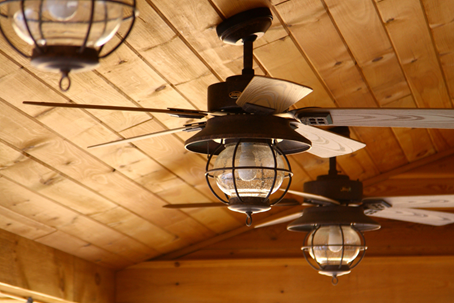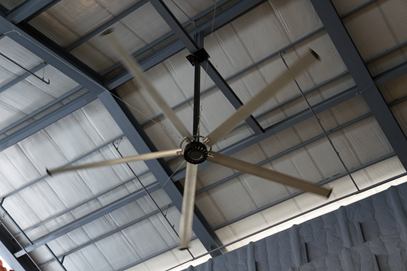
Not all ceiling fans are created equal. There are ceiling fans with five blades and ceiling fans with one blade; there are fans with seven-foot spans, and fans barely two feet across. There are black fans, white fans, wooden fans, caged fans, fans with lights, fans with remote controls and too many other different features to name. So which ceiling fan is right for you?
Here’s a guide to the most common types of ceiling fan. With this information, you should be able to identify the perfect ceiling fan for your space.
Standard
Almost all ceiling fans you have ever seen fit into this category. Standard ceiling fans are incredibly versatile, coming in a range of sizes and styles, from rustic and farmhouse to minimalist and modern. They improve the energy efficiency of a home by improving airflow to keep rooms cooler, and they usually don’t cost much to buy or install. If your room doesn’t have any idiosyncrasies, you will likely be happy with a standard ceiling fan in the style of your choosing.
Low Profile
Sometimes called flush-mount ceiling fans or hugger fans, low-profile ceiling fans are close to the ceiling, not hanging quite as low as standard fan models. This allows for more headspace, which can be crucial in rooms with low ceilings. You can opt for a low-profile ceiling fan without compromising on style — in fact, using a low-profile fan might improve the perceived proportions of your room by creating the illusion of higher ceilings. You should be aware that fans placed too close to the ceiling might have limited airflow and diminished cooling capacity, but if you install your low-profile ceiling fan properly, this shouldn’t be an issue.
Dual Motor
Dual motor ceiling fans, as the name suggests, have two motors, which allow for extraordinary control over the speed, direction and power of airflow. You can change the angle and direction of each fan head individually to spread airflow around the room, which is crucial for large, open spaces where cooling distant corners can be a concern. You might choose a dual motor fan if your room has a strange shape that demands more targeted airflow for effective cooling.
Damp and Wet
When you want to install a ceiling fan in a space that is subject to excessive moisture, you need a damp or wet ceiling fan. These fans are made with water-resistant and water-proof materials to protect their intricate workings from the ravages of moisture. Damp fans withstand humidity and moisture, and wet fans are completely waterproof, able to withstand heavy rainfall. If you want to install a fan in a moist indoor space, like a kitchen or bathroom, you might choose a damp fan, but any model installed in outside areas should probably be a wet fan.
Commercial and Industrial

Ceiling fans aren’t just for residential use. Commercial and industrial spaces can make good use of efficient airflow to keep goods and workers the appropriate temperature year-round. Commercial and industrial fans tend to be large, designed for massive open spaces and exceedingly high ceilings. What’s more, these fans rarely adhere to a design style, instead looking purely utilitarian with plain, straight metal blades. If you are looking for an enormous fan for a sizeable space on your property, like a barn or hangar, you might consider a commercial or industrial fan — but most homeowners don’t need such large or expensive fans for efficient airflow and cooling.
Conclusion
Ceiling fans last decades when they are properly installed, so you need to be certain you are buying a fan that fits your needs. It is critical that you consider the space where you will hang your fan — the size and shape of the room, its exposure to moisture, its access to outside air and more. You might consider looking for fans with specific features, like remote-operated fans or fans with Energy Star ratings. Many fans come with the option of adding a light kit, which means your fan can provide both airflow and ambient lighting to your space. Finally, you should consider the style of the fan; because it is a major element of your room, its look will contribute to the overall aesthetics of your space.
Now that you know a bit more about your options, you are closer than ever to finding the perfect fan for you.






